Effect of Ultrasonic Treatment on the Solidification Microstructure of Die-Cast 35CrMo Steel
Abstract
:1. Introduction
2. Materials and Methods
3. Results and Discussion
3.1. Effects of Ultrasonic Treatment on the Microstructure of the Ingots
3.2. Discussion
4. Conclusions
- (1)
- Compared with the microstructures of ingots, between conventional direct casting and ultrasonic casting, it can be found that ultrasonic treatment can be used to refine the solidification structure of 35CrMo steel, and can transform the microstructure from coarse dendritic to short staggered dendritic. To some extent, the solidification structure changed from dendritic to equiaxed grains after the introduction of ultrasonic treatment.
- (2)
- The microstructures from different positions in the samples, which are subjected to different ultrasonic acoustic pressures during ultrasonic treatment, show that there is a severe attenuation of ultrasounds in the molten melt. The closer the samples are to the radiator, the stronger the effect of ultrasonic treatment, and the more remarkable the refinement of the microstructures.
Acknowledgments
Author Contributions
Conflicts of Interest
References
- Abramov, V.; Abramov, O.; Bulgakov, V.; Sommer, F. Solidification of aluminium alloys under ultrasonic irradiation using water-cooled resonator. Mater. Lett. 1998, 37, 27–34. [Google Scholar] [CrossRef]
- Jian, X.; Xu, H.; Meek, T.T.; Han, Q. Effect of power ultrasound on solidification of aluminum A356 alloy. Mater. Lett. 2005, 59, 190–193. [Google Scholar] [CrossRef]
- Aghayani, M.K.; Niroumand, B. Effects of ultrasonic treatment on microstructure and tensile strength of AZ91 magnesium alloy. J. Alloy. Compd. 2011, 509, 114–122. [Google Scholar] [CrossRef]
- Zhai, W.; Wei, B. Peritectic solidification characteristics of Sb–Sn alloy under ultrasonic vibration. Mater. Lett. 2015, 138, 1–4. [Google Scholar] [CrossRef]
- Puga, H.; Barbosa, J.; Costa, S.; Ribeiro, S.; Pinto, A.M.P.; Prokic, M. Influence of indirect ultrasonic vibration on the microstructure and mechanical behavior of Al-Si-Cu alloy. Mater. Sci. Eng. A 2013, 560, 589–595. [Google Scholar] [CrossRef] [Green Version]
- Yao, L.; Hao, H.; Ji, S.H.; Fang, C.F.; Zhang, X.G. Effects of ultrasonic vibration on solidification structure and properties of Mg-8Li-3Al alloy. Trans. Nonferr. Met. Soc. China 2011, 21, 1241–1246. [Google Scholar] [CrossRef]
- Liu, Q.; Zhang, Y.; Song, Y.; Qi, F.; Zhai, Q. Influence of ultrasonic vibration on mechanical properties and microstructure of 1Cr18Ni9Ti stainless steel. Mater. Design. 2007, 28, 1949–1952. [Google Scholar]
- Liu, Q.; Zhai, Q.; Qi, F.; Zhang, Y. Effects of power ultrasonic treatment on microstructure and mechanical properties of T10 steel. Mater. Lett. 2007, 61, 2422–2425. [Google Scholar] [CrossRef]
- Kong, W.; Cang, D.Q.; Song, J.H. Effects of Ultrasonic Treatment during the Solidification Process on the Structure Formation of Low Carbon Steel. Mater. Trans. 2011, 52, 1844–1847. [Google Scholar] [CrossRef]
- Kang, J.; Zhang, X.; Hu, Y.; Ma, J.; Hu, Y.; Huang, T. Ultrasonic Treatment of the 304 Stainless Steel Melt. ISIJ Int. 2014, 54, 281–287. [Google Scholar] [CrossRef]
- Liang, G.; Shi, C.; Zhou, Y.J.; Mao, D.H. Numerical Simulation and Experimental Study of an Ultrasonic Waveguide for Ultrasonic Casting of 35CrMo Steel. J. Iron Steel Res. Int. 2016, 23, 772–777. [Google Scholar] [CrossRef]
- Qian, M.; Ramirez, A.; Das, A. Ultrasonic refinement of magnesium by cavitation: Clarifying the role of wall crystals. J. Cry. Growth 2009, 311, 3708–3715. [Google Scholar] [CrossRef]
- Qian, M.; Ramirez, A.; Das, A.; Stjohn, D.H. The effect of solute on ultrasonic grain refinement of magnesium alloys. J. Cry. Growth 2010, 312, 2267–2272. [Google Scholar] [CrossRef]
- Campanella, T.; Charbon, C.; Rappaz, M. Grain refinement induced by electromagnetic stirring: A dendrite fragmentation criterion. Metall. Mater. Trans. A 2004, 35, 3201–3210. [Google Scholar] [CrossRef]
- Flint, E.B.; Suslick, K.S. The temperature of cavitation. Science 1991, 253, 1397–1399. [Google Scholar] [CrossRef] [PubMed]
- Hickling, R. Transient, high-pressure solidification associated with cavitation in water. Phys. Rev. Lett. 1994, 73, 2853–2856. [Google Scholar] [CrossRef] [PubMed]
- Huang, H.; Shu, D.; Zeng, J.; Bian, F.; Fu, Y.; Wang, J.; Sun, B. In situ small angle X-ray scattering investigation of ultrasound induced nucleation in a metallic alloy melt. Scr. Mater. 2015, 106, 21–25. [Google Scholar] [CrossRef]
- Borkent, B.M.; Gekle, S.; Prosperetti, A.; Lohse, D. Nucleation threshold and deactivation mechanisms of nanoscopic cavitation nuclei. Phys. Fluids 2009, 21, 102003. [Google Scholar] [CrossRef]
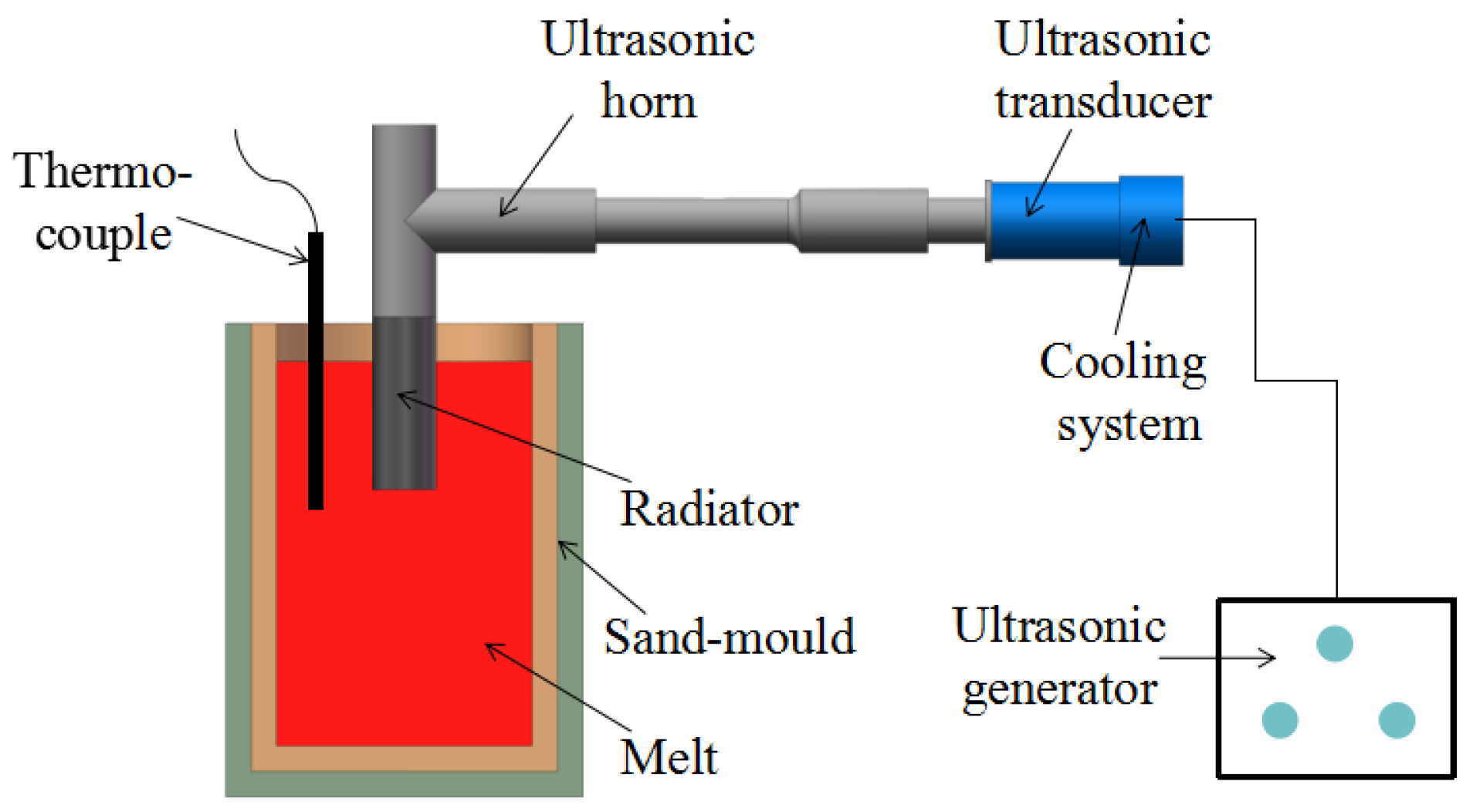
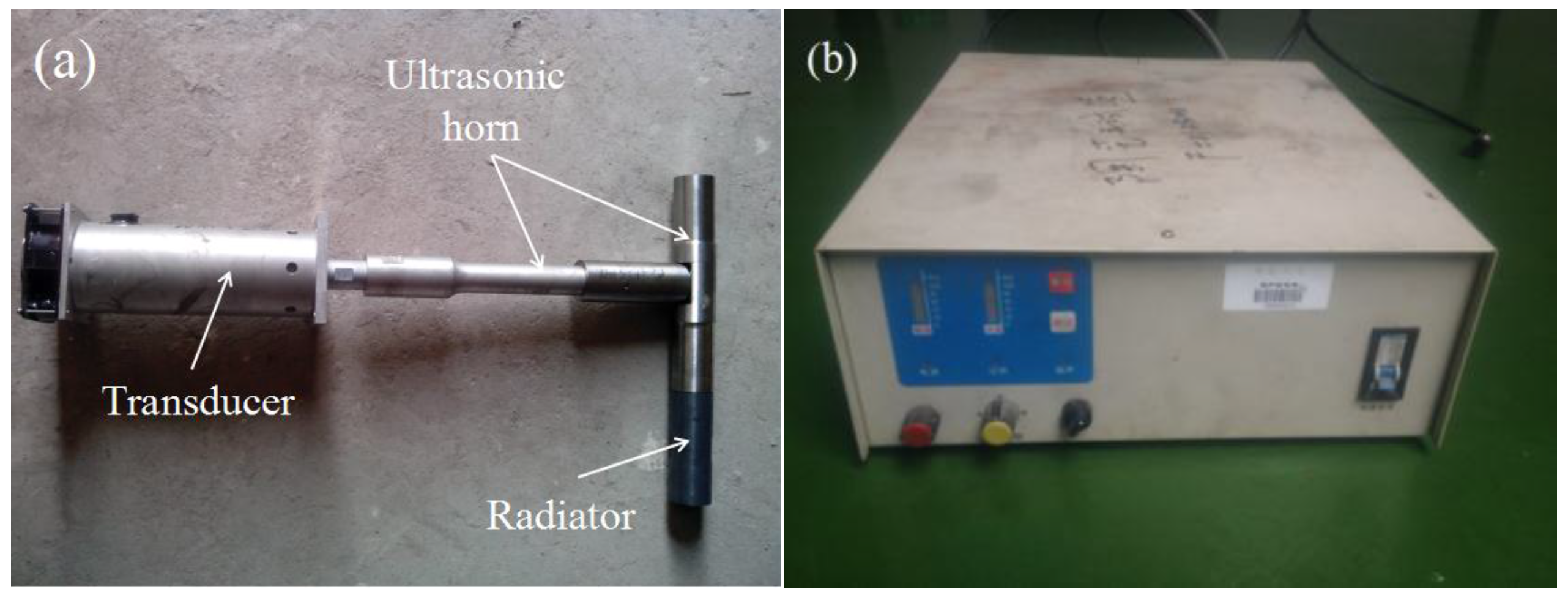
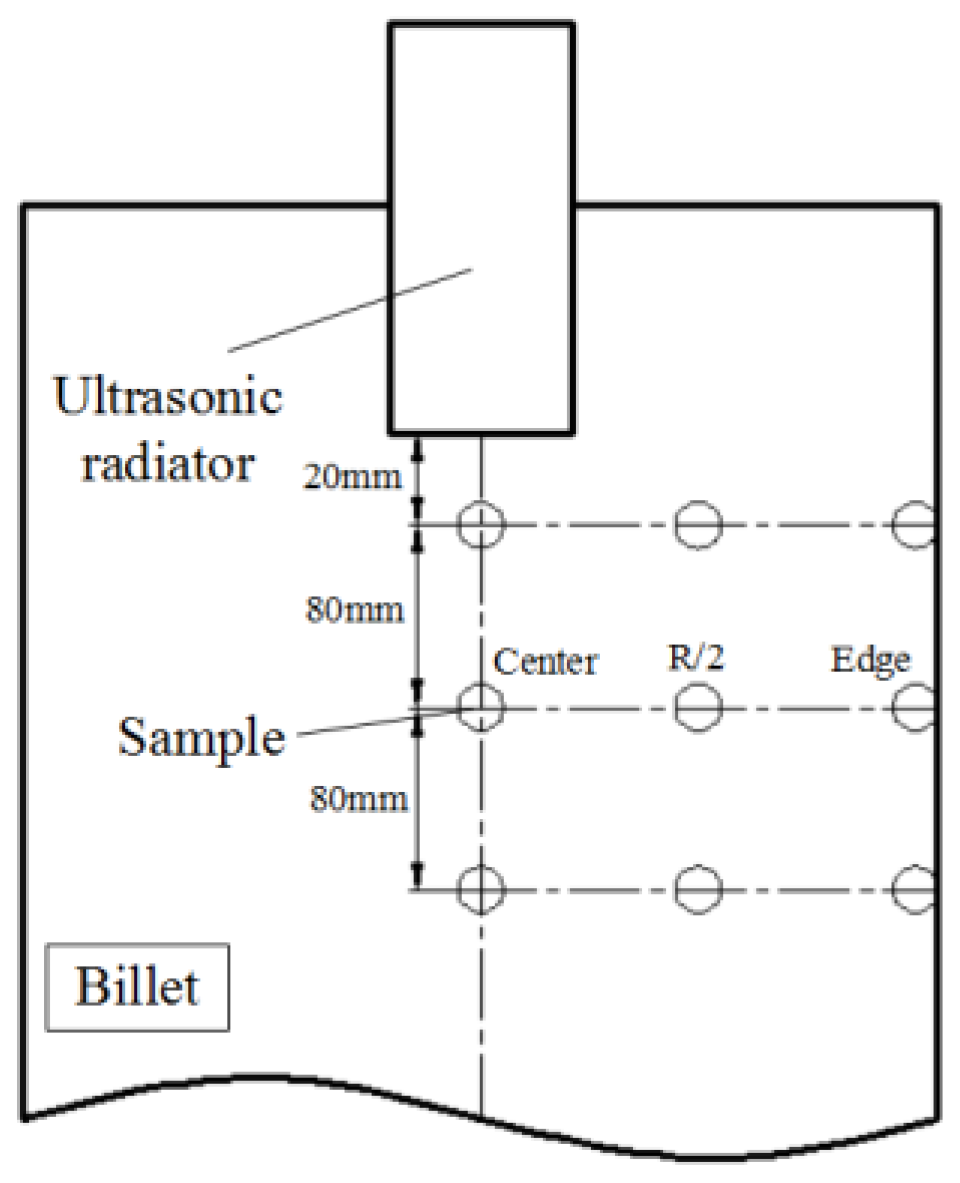
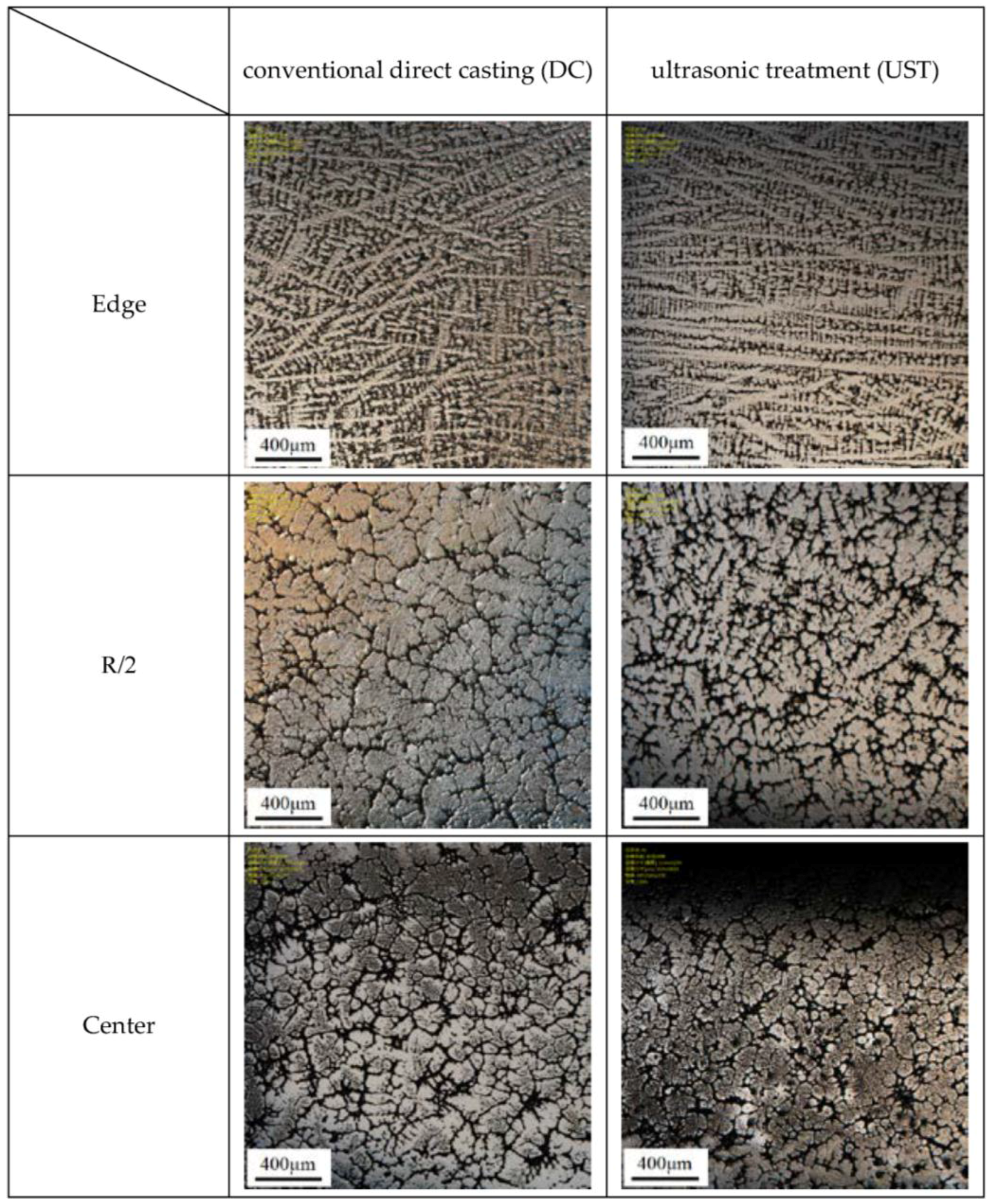
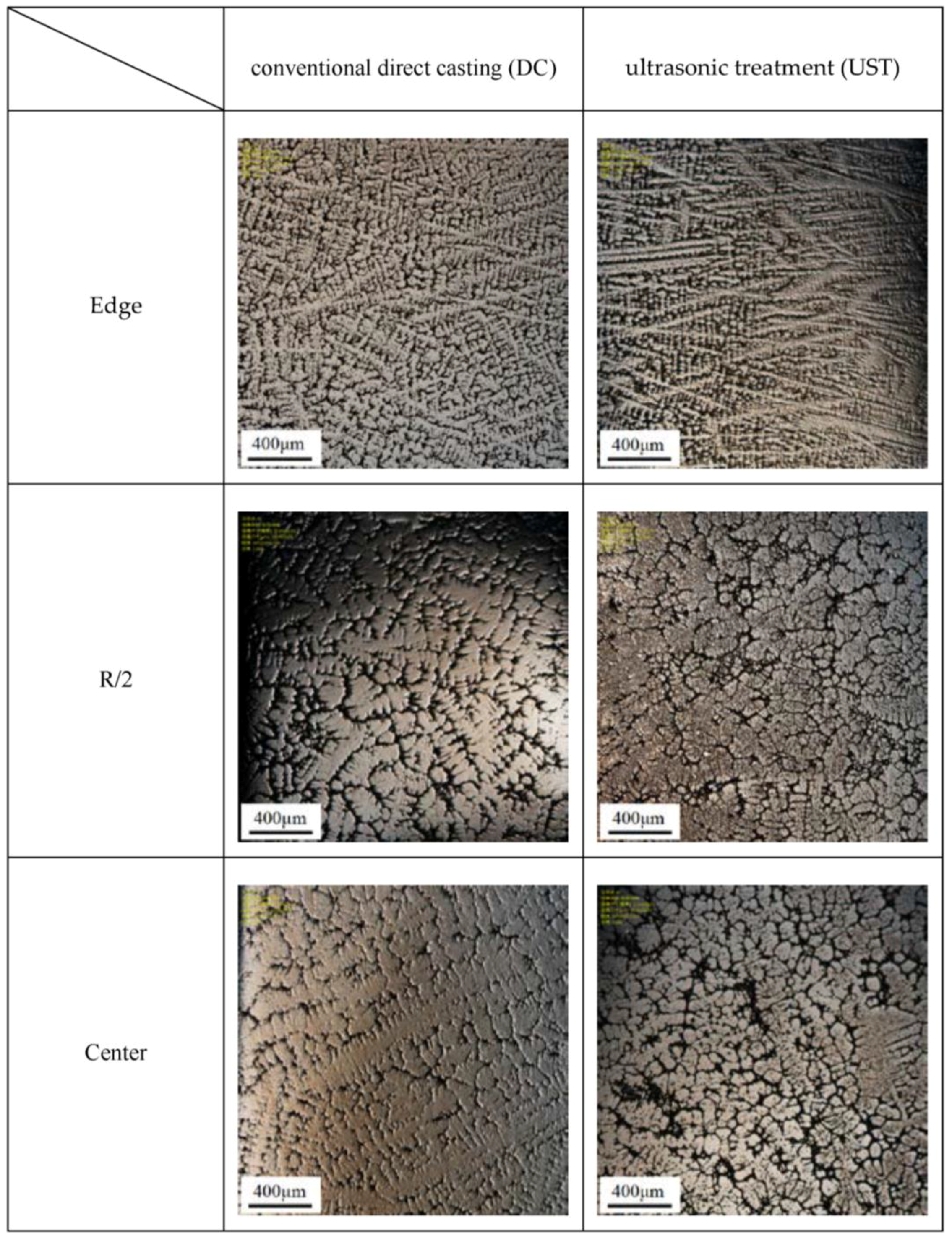

| Chemical Composition | C | Si | Mn | Cr | Mo | Ni | P | Fe |
|---|---|---|---|---|---|---|---|---|
| Mass fraction | 0.32 | 0.25 | 0.45 | 0.85 | 0.19 | 0.025 | 0.025 | Bal. |
© 2016 by the authors; licensee MDPI, Basel, Switzerland. This article is an open access article distributed under the terms and conditions of the Creative Commons Attribution (CC-BY) license (http://creativecommons.org/licenses/by/4.0/).
Share and Cite
Liang, G.; Shi, C.; Zhou, Y.; Mao, D. Effect of Ultrasonic Treatment on the Solidification Microstructure of Die-Cast 35CrMo Steel. Metals 2016, 6, 260. https://doi.org/10.3390/met6110260
Liang G, Shi C, Zhou Y, Mao D. Effect of Ultrasonic Treatment on the Solidification Microstructure of Die-Cast 35CrMo Steel. Metals. 2016; 6(11):260. https://doi.org/10.3390/met6110260
Chicago/Turabian StyleLiang, Gen, Chen Shi, Yajun Zhou, and Daheng Mao. 2016. "Effect of Ultrasonic Treatment on the Solidification Microstructure of Die-Cast 35CrMo Steel" Metals 6, no. 11: 260. https://doi.org/10.3390/met6110260






